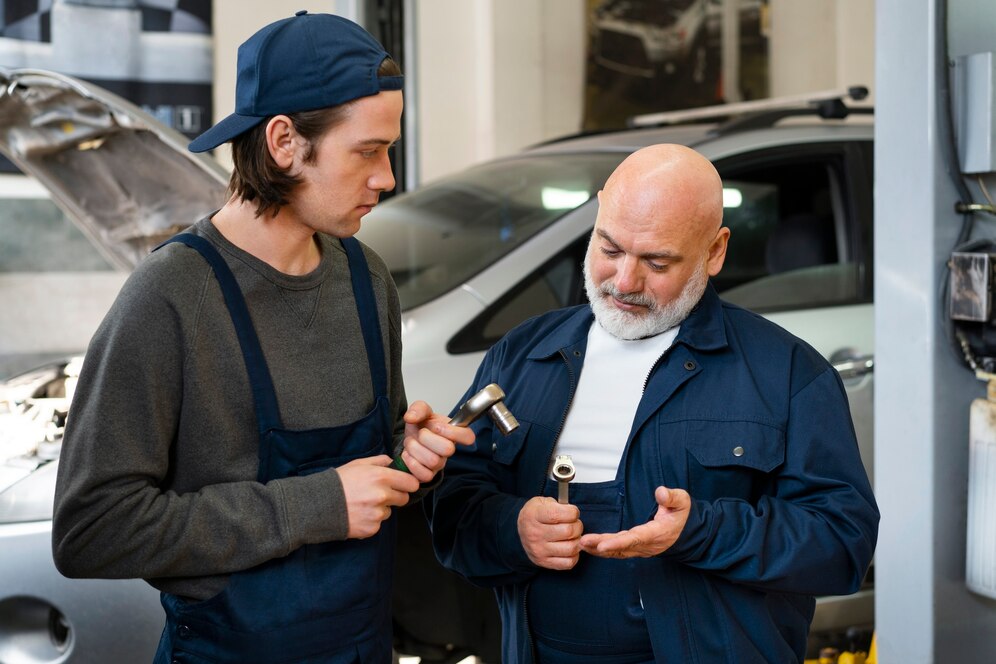Introduction
Car repairs can be a costly and time-consuming necessity for every vehicle owner. Whether it’s a minor issue like replacing a headlight or a more significant problem such as engine failure, knowing what you can fix yourself and when you should seek professional help can save you both money and stress. While modern vehicles are equipped with complex computerized systems, there are still many repairs and maintenance tasks that can be performed at home with basic tools and a little knowledge. This guide will explore the types of car repairs that you can safely tackle on your own, as well as the warning signs that indicate a job should be left to the professionals. Basic DIY Car Repairs You Can Handle

Changing the Oil Filter and Engine Oil
One of the most fundamental car maintenance tasks is changing the engine oil. Regular oil changes are crucial to keeping your engine running smoothly and prolonging its lifespan. To perform an oil change, you need a wrench, an oil filter wrench, a drain pan, and new oil. Start by draining the old oil, replacing the oil filter, and then adding fresh oil according to your vehicle’s specifications. This simple task can save you a significant amount of money compared to visiting a mechanic.
Replacing the Air Filter
The air filter prevents dust, dirt, and debris from entering your engine. A clogged air filter can reduce your vehicle’s efficiency and performance. Fortunately, replacing an air filter is one of the easiest car maintenance tasks. Most air filters are located under the hood and can be swapped out within minutes without any special tools. Regularly changing your air filter improves fuel economy and helps your engine breathe better.
Changing Spark Plugs
Spark plugs play a crucial role in igniting the fuel in your engine, and faulty ones can cause misfires, poor fuel economy, and difficulty starting the car. Replacing spark plugs requires a socket wrench and some patience. Depending on your vehicle, they typically need to be replaced every 30,000 to 100,000 miles. Ensuring that you use the correct type of spark plug and tightening them properly is essential to avoid engine issues.
Replacing Wiper Blades
Worn-out wiper blades can make driving in the rain hazardous. Luckily, replacing them is one of the simplest DIY car repairs. Most wiper blades can be installed without tools, and they typically come with instructions. Ensuring that you replace them at least once a year or whenever they start streaking will improve visibility and overall driving safety.
Replacing a Dead Battery
Car batteries typically last between three to five years, but extreme weather conditions and frequent short trips can shorten their lifespan. If your battery is dead, replacing it yourself is a straightforward process. You will need a wrench to remove the battery terminals and a new battery of the correct size. Always ensure the vehicle is turned off before attempting to replace the battery, and be cautious with handling battery acid.
Changing Brake Pads
While more complex brake repairs should be left to professionals, changing brake pads is a manageable task for DIY enthusiasts. If you hear squealing or grinding noises while braking, it might be time to replace the pads. The wheels must be taken off, the calipers must be unbolted, and the old brake pads must be replaced. Having a good understanding of how your braking system works is essential before attempting this repair.

When to Call a Professional Mechanic
While DIY car repairs can save money, some tasks require specialized tools, knowledge, and expertise. Attempting complex repairs without proper training can be dangerous and lead to costly mistakes. Here are some instances where professional help is advised:
Transmission Repairs
One of a vehicle’s most important and complex components is the transmission. It has intricate parts and fluid systems that need to be handled by experts. If you notice gear slipping, delayed shifting, or transmission fluid leaks, it’s best to take your car to a professional mechanic. Attempting transmission repairs without the right knowledge can result in severe damage and expensive repairs.
Engine Problems and Overheating Issues
If your check engine light is on or your car is overheating, diagnosing the problem yourself can be challenging. Engine repairs often involve extensive dismantling, special tools, and a deep understanding of automotive mechanics. A professional should be consulted because a wrong diagnosis or repair can cause more damage.
Suspension and Steering System Repairs
The suspension and steering system plays a vital role in vehicle control and safety. If you experience difficulty steering, excessive bouncing, or strange noises while driving, these are signs of potential suspension issues. Because repairing issues with the suspension necessitates sophisticated tools and experience, it is best left to certified mechanics.
Electrical System Repairs
Modern vehicles rely heavily on advanced electrical systems, including sensors, wiring harnesses, and onboard computers. If you experience electrical issues such as malfunctioning lights, dead power windows, or a failing alternator, diagnosing the root cause without specialized diagnostic tools can be nearly impossible. A professional mechanic has the necessary equipment to pinpoint and fix electrical problems accurately.
Major Brake System Issues
While replacing brake pads is a manageable DIY task, more serious brake problems, such as a failing master cylinder or brake fluid leaks, require professional intervention. Because a broken brake can be very dangerous, it’s important to have it checked and fixed by a trained mechanic to make sure your braking system is in good working order.
Essential Tools for DIY Car Repairs
If you plan to take on DIY car maintenance, having the right tools is essential. Here are some must-have tools for basic car repairs:Socket set and wrench set.Screwdrivers flathead and Phillips.Jack and Jack stand.Oil filter wrench.Multimeter for electrical testing.Pliers and adjustable wrench.For precise tightening, use a torque wrench.Work gloves and safety goggles. Investing in a good repair manual for your specific vehicle model can also be incredibly helpful.

Conclusion
DIY car repairs can be a rewarding and cost-effective way to maintain your vehicle, but knowing your limits is crucial. Simple maintenance tasks like changing oil, replacing filters, and swapping out spark plugs can be easily done at home, while complex repairs involving the transmission, engine, or suspension should be left to professional mechanics. By understanding which repairs are within your skill level and when to seek expert help, you can keep your car running smoothly while avoiding costly mistakes. Taking the time to learn basic car maintenance not only saves money but also helps you become a more knowledgeable and confident vehicle owner.

